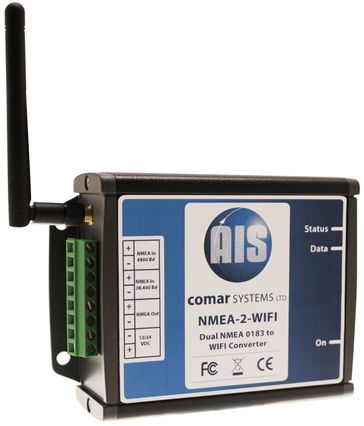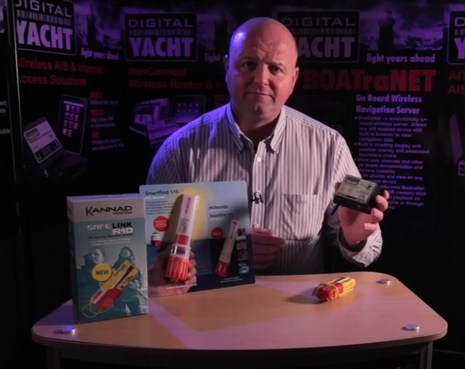Wireless data appliances: Comar NMEA-2-WiFi & DY AIS LifeGuard

The London Boat Show opened today and so far I've learned of two products being introduced there. It's somewhat odd that while both say "AIS" on the box neither is an AIS receiver or transponder. Certainly the Comar NMEA-2-WiFi box might be used to send AIS target info to apps like iNavX running on an iPad -- and given that Comar is all about AIS, it's likely -- but in fact its two NMEA 0183 inputs could be used for any data a user wants. Having two 0183 inputs, incidentally, is what seems to distinguish Comar's product from Digital Yacht's single input WLN boxes (though worth noting that the Brookhouse iMux has 4 inputs). Meanwhile DY came up with an entirely novel AIS-related data appliance...
The Digital Yacht AIS LifeSaver is specifically designed to solve a problem with the new AIS SARTs that are being used outside the U.S. now, and will soon be available in the States. (I say that hopefully, as the hold up is regulatory.) As I found when I first tested the easyRescue personal AIS SART, many AIS plotting devices aren't yet programmed to treat a SART target with proper seriousness (though it turned out later that the Raymarine E Wide did well). At any rate, as Nic Heyes explains in this DY video, the LifeGuard box simply listens to a NMEA 0183 AIS stream and sets off an internal 95db alarm and flashes a red warning light if it sees the SART message. It also has a relay that might be used for a bigger alarm or to send an MOB alert to certain autopilots or other gear.
While the AIS LifeGuard could be really useful on some boats right now, hopefully it will become unnecessary as MFD manufacturers adapt their gear to AIS SARTs. And the same may be eventually true of all the new devices designed to get boat data into mobile apps, though I'm definitely looking forward to Lab testing the DMK and Chetco boat-to-apps bridges this cold weekend in Maine. It would be nice, though, if Panbots in London let us know about any other new electronics seen at the show.


 Share
Share
I can imagine the "AIS" naming is only because one of the input ports is 38,400 which is typical of AIS receivers. It will be interesting to see if the Comar WiFi mix supports infrastructure mode in addition to the typical Ad Hoc mode.
The Comar WiFi should work fine with iNavX and MacENC. In the case of MacENC one could have a wired connection using the NMEA out to the Mac and then a WiFi connection to iNavX on iPad/iPhone.
I think Chetco SeaSmart have done things the best because they support both Ad Hoc and Infrastructure mode and an easy to use web interface for configuration. This is something all the other WiFi mux seem to lack. Also SeaSmart have been very receptive to feature suggestions.